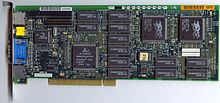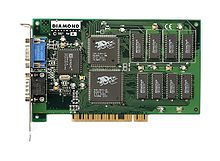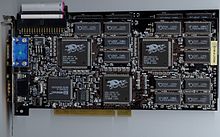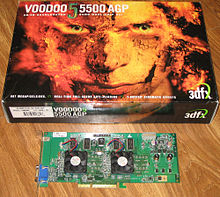- 3dfx Interactive
-
3dfx Interactive 
Industry Semiconductors Fate Bankrupt,[1] most assets bought by Nvidia, fate of remaining assets unknown. Successor Nvidia Founded 1994 Defunct 2002[1] Headquarters San Jose, California, USA Key people Ross Smith, Scott Sellers, Gary Tarolli Products Voodoo Graphics Series Website http://3dfx.com/ (archived version 2001-02-01) 3dfx Interactive was a company that specialized in the manufacturing of 3D graphics processing units and, later, graphics cards. It was a pioneer in the field for several years in the late 1990s until 2000 when it underwent one of the most high-profile demises in the history of the PC industry. It was headquartered in San Jose, California until, on the verge of bankruptcy, many of its intellectual assets (and many employees) were acquired by its rival, Nvidia. 3dfx Interactive filed for bankruptcy on October 15, 2002.[1][2]
Contents
Early history
Founded in 1994 by Ross Smith, Gary Tarolli and Scott Sellers (all SGI alumni) with backing from Gordie Campbell's TechFarm, 3dfx released its Voodoo Graphics chip in 1996. The company only manufactured the chips and some reference boards, and initially did not sell any product to consumers; rather, it acted as an OEM supplier for graphics card companies, which designed, manufactured, marketed, and sold their own graphics cards including the Voodoo chipset.
3dfx gained fame due to their great success within the arcade market. At the time, arcades were a very visible place to go visit and see the latest in 3D gaming and technology. The first arcade machine that 3Dfx Voodoo Graphics hardware was used in was called ICE Home Run Derby, a game released in 1996. Later that year they were featured in more popular titles, such as Atari's San Francisco Rush and Wayne Gretzky's 3D Hockey.[3] 3Dfx received a lot of focus from the media because of the obvious graphical prowess of these titles, and that new game consoles such as Nintendo 64, PlayStation, and Sega Saturn would be showcases for similar next-generation graphics.
Voodoo Graphics PCI
Towards the end of 1996, the cost of EDO DRAM dropped significantly and 3Dfx was able to enter the consumer PC hardware market with aggressive pricing compared to previous 3D graphics solutions for computers. The Voodoo heralded a new era of high-performance and high-quality 3D graphics for gaming. Prior to it, games such as Doom and Quake had compelled video game players to move from their 80386s to 80486s, and then to the Pentium.[4]
A typical Voodoo Graphics PCI expansion card consisted of a DAC, a frame buffer processor and a texture mapping unit, along with 4 MB of EDO DRAM. The RAM and graphics processors operate at 50 MHz. It provided only 3D acceleration and as such the computer also needed a traditional video controller for conventional 2D software. A pass-through VGA cable daisy-chained the video controller to the Voodoo, which was itself connected to the monitor. The method used to engage the Voodoo's output circuitry varied between cards, with some using mechanical relays while others utilized purely digital components. The mechanical relays emitted an audible "clicking" sound when they engaged and disengaged.
The Voodoo's primary competition were products from PowerVR and Rendition. PowerVR produced a similar 3D-only add-on card with capable 3D support, although it was not comparable to Voodoo Graphics in either image quality or performance. 3Dfx saw intense competition in the market from cards that offered the combination of 2D and 3D acceleration. While these cards, such as Matrox Mystique, S3 ViRGE, and ATI 3D Rage, offered unquestionably inferior 3D acceleration, their lower cost and simplicity often appealed to OEM system builders. Rendition's Vérité V1000 was an integrated (3D+VGA) single-chip solution as well that was perhaps Voodoo's closest competitor, but it too did not have comparable 3D performance and its 2D capabilities were considered merely adequate relative to other 2D cards of the time.
Glide API
Main article: Glide APIOriginally developed for arcade games that included non-Intel architectures, Glide was created to handle error prone tasks like chip initialization for the programmer, but implemented nothing more than what the Voodoo hardware was directly capable of. This strategy differed from that of other 3D APIs of the era (Direct3D, OpenGL, and QuickDraw 3D), which hid low-level hardware details behind an "abstraction layer", with the goal of providing application developers a standard, hardware-neutral interface.
The advantage of an abstraction layer is that game developers save programming effort and gain flexibility by writing their 3D rendering code once, for a single API, and the abstraction layer allows it to run on hardware from multiple manufacturers. This advantage is still in place today. However, in the early days of the 3D graphics card, Direct3D and OpenGL implementations were either non-existent or, at minimum, substantially less mature than today, and computers were much slower and had less memory. The abstraction layers' overhead crippled performance in practice. 3dfx had therefore created a strong advantage for itself by aggressively promoting Glide, which was designed specifically around the Voodoo hardware, and therefore did not suffer from the performance hit of a higher level abstraction layer.
While there were many hit games that used Glide, including several coin-op/arcade games from Midway Games and Atari Games (e.g., San Francisco Rush, NFL Blitz, Hydrothunder, etc.) and games like Eidos' Tomb Raider, the killer application for Voodoo Graphics was the MiniGL driver developed specifically to allow hardware acceleration of the game Quake, by id Software, on 3dfx cards. The driver implemented only the subset of OpenGL used by Quake.
By 2000, the improved performance of Direct3D and OpenGL on the average personal computer, coupled with the huge variety of new 3D cards on the market, the widespread support of these standard APIs by the game developer community and the closure of 3dfx, would make Glide obsolete.
Voodoo Rush
 Intergraph Intense3D Voodoo
Intergraph Intense3D Voodoo
In August 1997, 3dfx released the Voodoo Rush chipset, combining a Voodoo chip with a 2D chip that lay on the same circuit board, eliminating the need for a separate VGA card. Most cards were built with an Alliance Semiconductor AT25/AT3D 2D component, but there were some built with a Macronix chip and there were initial plans to partner with Trident but no such boards were ever marketed.
The Rush had the same specifications as Voodoo Graphics but did not perform as well because the Rush chipset had to share memory bandwidth with the CRTC of the 2D chip. Furthermore, the Rush chipset was not directly present on the PCI bus but had to be programmed through linked registers of the 2D chip. Like the Voodoo Graphics, there was no interrupt mechanism, so the driver had to poll the Rush in order to determine whether a command had completed or not; the indirection through the 2D component added significant overhead here and tended to back up traffic on the PCI interface. The typical performance hit was around 10% compared to Voodoo Graphics, and even worse in windowed mode. Later Rush boards released by Hercules had 8 MiB VRAM and a 10% higher clock speed to close the performance gap.
A rare third version was produced which featured a Cirrus Logic 2D chip. This version fixed the PCI bus collisions and memory interface problems.
Some manufacturers bundled a PC version of Atari Games' racing game San Francisco Rush, the arcade version of which used a Voodoo Graphics chipset.
Sales of the Voodoo Rush cards were very poor, and the cards were discontinued within a year. The company would not attempt another 2D/3D solution again until the release of the Voodoo Banshee in 1998.
Voodoo2
Main article: Voodoo2In 1998, 3dfx released Voodoo's successor, the popular Voodoo2. The Voodoo2 was architecturally similar, but the basic board configuration added a second texturing unit, allowing two textures to be drawn in a single pass.
The Voodoo2 required three chips and a separate VGA graphics card, whereas new competing 3D products, such as the ATI Rage Pro, Nvidia RIVA 128, and Rendition Verite 2200, were single-chip products. Despite some shortcomings, such as the card's dithered 16-bit 3D color rendering and 800×600 resolution limitations, no other manufacturers' products could match the smooth framerates that the Voodoo2 produced. It was a landmark (and expensive) achievement in PC 3D-graphics. Its excellent performance, and the mindshare gained from the original Voodoo Graphics, resulted in its success. Many users even preferred Voodoo2's dedicated purpose, because they were free to use the quality 2D card of their choice as a result. Some 2D/3D combined solutions at the time offered quite sub-par 2D quality and speed.
The arrival of the Nvidia RIVA TNT with integrated 2D/3D chipset would offer minor challenge to the Voodoo2's supremacy months later.
SLI
The Voodoo2 introduced Scan-Line Interleave (SLI) to the gaming market. In SLI mode, two Voodoo2 boards were connected together, each drawing half the scan lines of the screen. For the price of a second Voodoo2 board, users could easily improve 3D throughout. A welcome result of SLI mode was an increase in the maximum resolution supported, now up to 1024×768. However, due to the high cost and inconvenience of using three separate graphics cards (two Voodoo 2 SLI plus the general purpose 2D graphics adapter), the Voodoo2 SLI scheme, though revolutionary at the time, had minimal effect on the total market share that the Voodoo2 held and was not a financial success.
The potential of the Voodoo2's SLI was limited by CPU bottlenecking[5] Still, the long-term accomplishment of this technology can be seen in its usefulness in gaming as late as 2004.[6]
SLI capability was not offered in subsequent 3dfx board designs, although the technology would be later used to link the VSA-100 chips on the Voodoo 5.
Having since acquired 3dfx, Nvidia in 2004 reintroduced the SLI brand (initially called Scalable Link Interface) in the GeForce 6 Series. ATI Technologies has also since introduced its own multi-chip implementation, dubbed "CrossFire". Although NVIDIA SLI and ATI Crossfire operate on the original SLI principle of utilizing the power of multiple video cards, the implementation is different.
Voodoo Banshee
 Creative 3D Blaster Banshee AGP
Creative 3D Blaster Banshee AGP
Near the end of 1998, 3dfx released the Voodoo Banshee, which used a lower price achieved through higher component integration, and a more complete feature-set including 2D acceleration, to target the mainstream consumer market. A single-chip solution, the Banshee was a combination of a 2D video card and partial (only one texture mapping unit) Voodoo2 3D hardware. Due to the missing second TMU, in 3D scenes which used multiple textures per polygon, the Voodoo2 was significantly faster. However, in scenes dominated by single-textured polygons, the Banshee could match or exceed the Voodoo2 due to its higher clock speed and resulting greater pixel fillrate. While it was not as popular as Voodoo Graphics or Voodoo2, the Banshee sold a respectable number of units.
Banshee's 2D acceleration was the first such hardware from 3Dfx and it was very capable. It rivaled the fastest 2D cores from Matrox, Nvidia, and ATI. It consisted of a 128-bit 2D GUI engine and a 128-bit VESA VBE 3.0 VGA core. The graphics chip capably accelerated DirectDraw and supported all of the Windows Graphics Device Interface (GDI) in hardware, with all 256 raster operations and tertiary functions, and hardware polygon acceleration. The 2D core achieved near-theoretical maximum performance with a null driver test in Windows NT.[7][8]
While Nvidia had yet to launch a product in the add-in board market that sold as well as 3dfx's Voodoo line, the company was gaining steady ground in the OEM market. The Nvidia RIVA TNT was a similar, highly integrated product that had two major advantages in greater 3D speed and 32-bit 3D color support. 3dfx, by contrast, had very limited OEM sales, as the Banshee was only adopted in small numbers by OEMs.[9]
Dreamcast
In 1997, 3dfx was working with entertainment company Sega to develop a new video game console hardware platform. Sega solicited two competing designs: a unit code-named "Katana", developed in Japan using NEC and VideoLogic technology, and "Blackbelt", a system designed in the United States using 3dfx technology.
However on July 22 of 1997, Sega announced that it was terminating the development contract (EN, July 28). At that time Sega actually told 3Dfx it was going to use NEC's PowerVR chipset for its game console, said Ms. Onopchenko. Sega told 3Dfx it had not terminated the contract because of the chipset performance and gave no indication as to why it decided to terminate the contract with 3Dfx, added Ms. Onopchenko, "We have requested that Sega return our confidential information and technology and they have failed to honor that request for one month now," said Ms. Onopchenko. "We believe there is a risk because Sega has no sign of returning our trade secrets and now is working with a competitor in NEC."
3Dfx said Sega has still not given a reason as to why it terminated the contract or why it chose NEC's accelerator chipset over 3Dfx's.
According to Dale Ford, senior analyst at Dataquest, a market research firm based in San Jose, Calif., a number of factors could have influenced Sega's decision to move to NEC, including NEC's proven track record of supplying chipsets for the Nintendo 64 and the demonstrated ability to be able to handle a major influx of capacity if the company decided to ramp up production on a moment's notice.
"This is a highly competitive market with price wars happening all the time and it would appear that after evaluating a number of choices—and the ramifications each choice brings—Sega went with a decision that it thought was best for the company's longevity," said Mr. Ford. "Sega has to make a significant move to stay competitive and they need to make it soon. Now whether this move is to roll out another home console platform or move strictly to the PC gaming space is unknown."
Sega quickly quashed "Blackbelt" and used "Katana" as the model for the product that would be marketed and sold as the Dreamcast. 3dfx sued Sega for breach of contract, accusing Sega of starting the deal in bad faith in order to take 3dfx technology. The case was settled out of court.
Decline
In early 1998, 3dfx embarked on a new development project. The Rampage development project was new technology for use in a new graphics card that would take approximately two years to develop, and would supposedly be several years ahead of the competition once it debuted. The company hired hardware and software teams in Austin, Texas to develop 2D and 3D Windows device drivers for Rampage in the summer of 1998. The hardware team in Austin initially focused on Rampage, but then worked on transform and lighting (T&L) engines and on MPEG decoder technology. (Later, these technologies were part of the Nvidia asset purchase in December 2000.)
Voodoo3 and strategy shift
Main article: Voodoo33dfx executed a major strategy change just prior to the launch of Voodoo3 by purchasing STB Technologies, which was one of the larger graphics card manufacturers at the time; the intent was for 3dfx to start manufacturing, marketing, and selling its own graphics cards, rather than functioning only as an OEM supplier. STB was obviously intended to give 3dfx access to that company's considerable OEM resources and sales channels, but the intended benefits of the acquisition never materialized. The two corporations were vastly different entities, with different cultures and structures, and they never integrated smoothly.[10]
STB prior to the 3dfx acquisition also approached Nvidia as a potential partner to acquire the company. At the time, STB was Nvidia's largest customer and was only minimally engaged with 3dfx. 3dfx management mistakenly believed that acquiring STB would ensure OEM design wins with their products and that product limitations would be overcome with STB's knowledge in supporting the OEM sales/design win cycles. Nvidia decided not to acquire STB and to continue to support many brands of graphics board manufacturers. After STB was acquired by 3dfx, Nvidia focused on being a virtual graphics card manufacturer for the OEMs and strengthened its position in selling finished reference designs ready for market to the OEMs. STB's manufacturing facility in Juarez, Mexico was not able to compete from either a cost or quality point of view when compared to the burgeoning Original design manufacturers (ODMs) and Contract electronic manufacturers (CEMs) that were delivering solutions in Asia for Nvidia. Prior to the STB merger finalizing, some of 3dfx's OEMs warned the company that any product from Juarez will not be deemed fit to ship with their systems, however 3dfx management believed these problems could be addressed over time. Those customers generally moved to Nvidia solutions and no longer chose to ship 3dfx products.
The acquisition of STB was one of the main contributors to 3dfx's downfall; the company did not sell any Voodoo 4 or 5 chips to third party manufacturers which were a significant source of revenue for the company. These third-party manufacturers turned into competitors and began sourcing graphics chips from NVIDIA. This also further alienated 3dfx's remaining OEM customers, as they had a single source for 3dfx products and could not choose a CEM to provide cost flexibility. The OEMs saw 3dfx as a direct competitor in retail. With the purchase of STB 3dfx created a line of Velocity boards (a STB brand) that used crippled Voodoo3 chips, as a product to target the low-end market. The chip came with only a single functional TMU, making it similar to a Voodoo Banshee.
As 3dfx focused more on the retail graphics card space, further inroads into the OEM space were limited. A significant requirement of the OEM business was the ability to consistently produce new products on the six month product refresh cycle the computer manufacturers required; 3dfx did not have the methodology nor the mindset to focus on this business model. In the end, 3dfx opted to be a retail distribution company manufacturing their own branded products.
The Voodoo 3 was heavily hyped as the graphics card that would make 3dfx the undisputed leader but the actual product was below expectations. Though it was still the fastest as it edged the RIVA TNT2 by a small margin, the Voodoo3 lacked 32-bit color and large texture support. Though at that time few games supported large textures and 32-bit color, and those that did generally were too demanding to be run at playable framerates, the features "32-bit color support" and "2048x2048 textures" were much more impressive on paper than 16-bit color and 256x256 texture support. The Voodoo3 sold relatively well, but was disappointing compared to the first two models and 3dfx gave up the market leadership to Nvidia.
As 3dfx attempted to counter the TNT2 threat, it was surprised by Nvidia's GeForce 256. The GeForce was a single-chip processor with integrated transform, lighting, triangle setup/clipping (hardware T&L), and rendering engines, giving it a significant performance advantage over the Voodoo3.
Voodoo 4 and 5
Main article: Voodoo 5The company's next (and as it would turn out, final) product was code-named Napalm. Originally, this was just a Voodoo3 modified to support newer technologies and higher clock speeds, with performance estimated to be around the level of the RIVA TNT2. However, Napalm was delayed, and in the meantime Nvidia brought out their landmark GeForce 256 chip, which shifted even more of the computational work from the CPU to the graphics chip. Napalm would have been unable to compete with the GeForce, so it was redesigned to support multiple chip configurations, like the Voodoo2 had. The end-product was named VSA-100, with VSA standing for Voodoo Scalable Architecture. 3dfx was finally able to have a product that could defeat the GeForce.
However, by the time the VSA-100 based cards made it to the market, the GeForce 2 and ATI Radeon cards had arrived and were offering higher performance at that price point. The only real advantage the Voodoo 5 5500 had over the GeForce 2 GTS or Radeon was its superior anti-aliasing implementation, and the fact that it didn't take such a large performance hit (relative to its peers) when anti-aliasing was enabled. 3dfx was fully aware of the Voodoo 5's speed deficiency, so they touted it as quality over speed, which was a reversal of the Voodoo 3 marketing which emphasized raw performance over features. 5500 sales were respectable but volumes were not at a level to keep 3dfx afloat.
The Voodoo 5 5000, which had 32 MB of VRAM to the 5500's 64 MB, was never launched, as the smaller frame buffer didn't significantly reduce cost over the Voodoo 5 5500.
The only other member of the Voodoo 5 line, the Voodoo 4 4500, was as much of a disaster as Voodoo Rush, because it had performance well short of its value-oriented peers combined with a late launch. Voodoo 4 was beaten in almost all areas by the GeForce 2 MX — a low-cost board sold mostly as an OEM part for computer manufacturers — and the Radeon VE.[11]
One unusual trait of the Voodoo 4 and 5 was that the Macintosh versions of these cards had both VGA and DVI output jacks, whereas the PC versions only had the VGA connector. Also, the Mac versions of the Voodoo 4 and 5 had an Achilles' heel in that they did not support hardware-based MPEG2 acceleration, which hindered the playback of DVDs on a Mac equipped with a Voodoo graphics card.
The Voodoo 5 6000 never made it to market, due to a severe bug resulting in data corruption on the AGP bus on certain boards, and was limited to AGP 2x. It was thus incompatible with the then-new Pentium 4 motherboards. Later tests proved that the Voodoo 5 6000 outperformed not only the GeForce 2 GTS and ATI Radeon 7200, but also the faster GeForce 2 Ultra and Radeon 7500. In some cases it was shown to compete well with the GeForce 3, trading performance places with the card on various tests.[12] However, the prohibitively high production cost of the card, particularly the 4 chip setup, external power supply and 128 MB of VRAM (a very large amount back then), would have likely hampered its competitiveness.
Acquisition and bankruptcy
In late 2000, not long after Voodoo 4's launch, several of 3dfx's creditors decided to initiate bankruptcy proceedings. 3dfx, as a whole, would have had virtually no chance of successfully contesting these proceedings, and instead opted to be bought by Nvidia; ceasing to exist as a company. The history of and participants in the 3dfx/Nvidia deal making can be read in the respective companies financial filings from that time period. The resolution and legality of those arrangements (with respect to the purchase, 3dfx's creditors and its bankruptcy proceedings) were still being worked through the courts as of February 2009[update], nearly 9 years after the sale. A majority of the engineering and design team working on "Rampage" (the successor to the VSA-100 line) that remained with the transition, were requested and remained in house to work on what became the GeForce FX series. Others are known to have accepted employment with ATI to bring their knowledge to the creation of the X series of video cards and reform their own version of SLI known as "Crossfire" and yet another interpretation of 3Dfx's SLI ideal.[citation needed]
After Nvidia acquired 3dfx, mainly for its intellectual property, they announced that they would not provide technical support for 3dfx products. Drivers and support are still offered by community websites. However, while being functional, the drivers do not carry a manufacturer's backing and are treated as "Beta" by users still wanting to deploy 3dfx cards in more current systems. Nvidia offered a limited time program under which 3dfx owners could trade in their cards for Nvidia cards of equal performance value [13]. On December 15, 2000 3dfx apologized to the customers with a final press release.[14]
Cause of decline
The cause of 3dfx's decline is a debated topic assuming several factors contributed in some measure. One of the first reactions was that there were rare claims that the company spent too lavishly on employee perqs including unsupported reports of spending $30,000–50,000 on company lunches and other non-essentials each month, even up to the last two weeks before closing its doors. Others state that these expenses were simply umbrella figures and entirely legitimate during the consideration of a sell. Not just fine dining and lunches, but luncheons over a period of time which is very typical for any large company.[citation needed]
Second, the company prioritized its next-generation designs and resulting high-end products, frequently ignoring the mid and low end sectors. Nvidia chose comparatively short development cycles, typically releasing a new product line each cycle and a high-end refresh midway through, and generally had a product priced to suit each market segment as older products and technologies moved progressively down-market. ATI quickly adopted a similar schedule. 3dfx however pursued lengthy, ambitious development cycles on higher end products and then attempted to fill in the down-market sectors with detuned versions of the newest release. This strategy eventually faltered as Nvidia and ATI cards built successively upon earlier gains, eventually exceeding 3dfx in overall performance. Nvidia's flagship GeForce 256 and GeForce 2 GTS are often given credit for the demise of the competing Voodoo 3 and Voodoo 5, respectively, but it is also important to note that the GeForce 2 MX midrange derivative was what successfully targeted the mass-market. The MX acquired substantial market share for Nvidia, and 3dfx's reaction, the Voodoo 4 4500, was uncompetitive in both price and performance when finally released.
Third, although 1997 was marked by analysts as a turning point for 3dfx due to the marketing led by the new CEO Greg Ballard, there was criticism of Ballard's understanding of R&D in the graphics industry. Single-card 2D/3D solutions were taking over the market, and although Ballard saw the need and attempted to direct the company there with the Voodoo Banshee and the Voodoo3, both of these cost the company millions in sales and lost market share while diverting vital resources from the Rampage project.[4] Then 3dfx released word in early 1999 that the still-competitive Voodoo2 would only support OpenGL and Glide under Microsoft's Windows 2000 operating system, and not DirectX. Many games were transitioning to DirectX at this point, and the announcement caused many PC gamers – the core demographic of 3dfx's market – to switch to Nvidia or ATI offerings for their new machines.
Fourth, the merger with STB alienated 3dfx from much of its previous market, and never developed into the right kind of arrangement to broaden 3dfx's distribution base from what the company had when still acting as a chipset supplier to third parties. The merger consequently diverted vital resources from 3dfx's chip development operations without ever producing a corresponding payback in sales.
Fifth, the next-generation "Rampage" project was exceedingly ambitious and delayed repeatedly as the company continued to vacillate on its commitment to Rampage development versus short-term retail products, such as the Voodoo 3 and Napalm/VSA-100. The Rampage design team was using a pioneering synthesis tool set which was still under development as the design proceeded. Originally scheduled for demonstration at the 1998 Comdex event, the first functional samples of the product only debuted in 3dfx's labs in December 2000. The 2D and 3D driver software was already up and running to support the test hardware, but the impending release of Rampage was too little, too late. The deal to "wind down" the company and transfer core assets to Nvidia was less than 2 weeks from closure at that point.
Sixth, 3dfx never incorporated scan test structures into their chips, without which thorough post production chip testing is impossible, removing the possibility of yield diagnostics. This is also noted by the purchasing party (nVidia) that incorporate such tests and continue to have lower yields than prospected although said "needed" test is mandatory for thrusting yields.
While some have speculated that shipping the "Rampage" might have saved 3dfx, the fact remains that the company never mastered the new concept of relatively cheap, high-performance designs with integrated 3D acceleration, which was rapidly becoming the de facto standard of PC graphics vise 2D. The success of "Rampage" would not have simply depended upon raw performance and the up and coming public awareness based on reviewers moving to the web, but also the cost of manufacturing. It remains unknown whether "Rampage" would have been a practical product, let alone enough to keep the company alive in the card industry.
Chipset table
Chipset Release Date Components
(PPxTMU)6Core
(MHz)Memory
(MHz)Fillrate7
Pix/TexMemory
Bus Width9Memory
(MiB)Bus Voodoo Graphics October 1996 SST-1 chipset (1x1). No VGA. 50 50 50/50 64-bit×2 4/6 EDO PCI Voodoo Rush April 1997 SST-96 chipset (1x1). 2D+3D Chip. 75 75 75/75 64-bit×2 6/8 EDO PCI Voodoo2 January 1998 SST-2 chipset (1x2). No VGA. 90 90 90/180 64-bit×3 8/12 EDO PCI Voodoo Banshee October 1998 Single-Chip (1x1) (2D/3D) 100 110 100/100 128-bit 8/16 SD/SG AGP 1x/PCI Velocity 100 July 1999 Avenger core (1x1). 1 Disabled TMU. 143 143 143/143 128-bit 8 SG AGP 2x Velocity 200 Not released Avenger core (1x1). 1 Disabled TMU. 143 143 143/143 128-bit 16 SG AGP 2x Voodoo3 1000 March 1999 Avenger core (1x2) 125 125 125/250 128-bit 8 SG AGP 2x Voodoo3 2000 April 1999 Avenger core (1x2) 143 143 143/286 128-bit 16 SD/SG AGP 2x/PCI Voodoo3 3000 April 1999 Avenger core (1x2) 166 166 166/333 128-bit 16 SD/SG AGP 2x/PCI Voodoo3 3500 July 1999 Avenger core (1x2), A/V processor 183 183 183/366 128-bit 16 SD AGP 2x Voodoo 4-2 4200 Not released 1 x VSA-1018 (2x1) 183 183 366/366 64-bit 32 DDR AGP 4x/PCI Voodoo 4 45005 October 2000 1 x VSA-100 (2x1) 166 166 333/333 128-bit 32 SD AGP 4x/PCI Voodoo 4 4800 Not released 1 x VSA-100 (2x1) 166 166 333/333 128-bit 64 SD AGP 4x/PCI Voodoo 5 5000 Not released 2 x VSA-100 (2x1) 166 166 667/667 128-bit×2 321 SG AGP 2x/PCI Voodoo 5 55005 June 2000 2 x VSA-100 (2x1) 166 166 667/667 128-bit×2 642 SD AGP 2x/PCI Voodoo 5 6000 Not released 4 x VSA-100 (2x1) 166/1664 166/1664 1333/1333 128-bit×4 1283 SD AGP 2x Spectre 1000 Not released 1 x Rampage (4x1) 200-250 (planned) 200-250 (planned) 800-1000 128-bit 64 DDR AGP 4x Spectre 2000 Not released 1 x Rampage (4x1) + 1 x Sage T&L-Chip 200-250 (planned) 200-250 (planned) 800-1000 128-bit 64 DDR AGP 4x Spectre 3000 Not released 2 x Rampage (4x1) + 1 x Sage T&L-Chip 200-250 (planned) 200-250 (planned) 1600-2000 128-bit 128 DDR AGP 4x Notes:
- 1 Shared by two processors; effectively 16 MiB VRAM.
- 2 Shared by two processors; effectively 32 MiB VRAM.
- 3 Shared by four processors; effectively 32 MiB VRAM.
- 4 The Voodoo 5 6000 was originally intended to have a core and memory clock of 183 MHz, but 3dfx reduced the clock speed to 166 MHz in an attempt to get the boards stable while operating in 2/4/8x AA modes. Since the instability problem was due to a design flaw in the PCB the reduction in clockspeed did nothing in regards to the problem. 3400 and 3700 boards with the "PCI bus modification" by ex-3dfx engineer H.S. run stable in all modes with speeds upwards of 190 MHz.
- 5 Macintosh versions were released later with the same specs, but only in PCI (66 MHz).
- 6 Pixel pipeline/s x Texture management unit/s (TMU).
- 7 Fillrate is measured in Megapixels/sec for pixel fillrate and Megatexels/sec for texture fillrate. Taking advantage of double texture fillrate per clock cycle requires the game engine to make use of multitexturing.
- 8 Daytona core
- 9 Voodoo boards with multiple chips often have independent memory buses for each chip's memory bank. This resulted in boards with large amounts of memory, but the memory was split between the completely separate chips. So while a Voodoo2 has 8 or 12 MiB of RAM, this RAM is split up between the texture and framebuffer.
-
- In the case of Voodoo2 12 MiB, there is 4 MiB texture RAM for each texture processor and 4 MiB for the framebuffer. When a game is not multitexturing, a total of 8 MiB texture memory is available. With multitexturing, this is halved to 4 MiB. SLI, however, does not double the available RAM because the boards separately calculate their part of the scene.
-
- This split-RAM architecture caused the resolution limits on the older boards. For Voodoo Graphics' 4 MiB RAM (2 MiB framebuffer) framebuffer size only allowed for a 640 × 480 resolution when z-buffering was used. Some games managed 800 × 600 without z-buffer, such as MechWarrior 2 3Dfx Edition, Jedi Knight, and Need for Speed III.[15]
See also
- Graphics card
- Graphics processing unit
References
- ^ a b c SEC filings, Form 8-K: Bankruptcy or receivership, updated October 21, 2002, retrieved August 17, 2007
- ^ [1], April 30, 2008 Bankruptcy Court decision on the value of 3dfx. A djvu file of 88 pages, 420 KB.
- ^ Donovan, Gary. "3dfx/Quantum3D Arcade Hardware". The Dodge Garage. http://www.thedodgegarage.com/3dfx/q3d_arcade.htm. Retrieved 2006-07-26.
- ^ a b A Fallen Titans Final Glory
- ^ Churchill. Celeron @450 + Voodoo2 SLI
- ^ Doom Doom3 + Voodoo2_Patch_v1_0
- ^ Pabst, Thomas. New 3D Chips - Banshee, G200, RIVA TNT And Savage3D, Tom's Hardware, August 18, 1998.
- ^ 3dfx Specifications: Voodoo Banshee AGP/PCI, 3dfxzone, accessed July 26, 2006.
- ^ [2]
- ^ A Fallen Titans Final Glory: The Golden Age
- ^ Lal Shimpi, Anand. 3dfx Voodoo4 4500AGP, Anandtech, October 23, 2000.
- ^ Jasper. 3dfx Voodoo 5 6000 Review, Sudhian, July 26, 2006.
- ^ "Got Voodoo – Get Verto” Promotion. [3]
- ^ Letter to Customers
- ^ Kanajana. Kanajana's Mechwarrior 2 3D Page, updated November 13, 2005. Archived 2009-10-22.
Categories:- Companies established in 1994
- Companies that have filed for Chapter 11 bankruptcy
- Graphics hardware companies
- Defunct computer companies of the United States
- Nvidia
- Companies disestablished in 2002
- Companies based in San Jose, California
- Defunct companies based in California
- Defunct computer hardware companies
Wikimedia Foundation. 2010.





